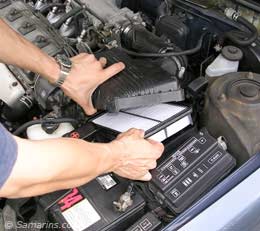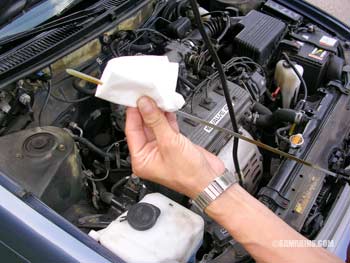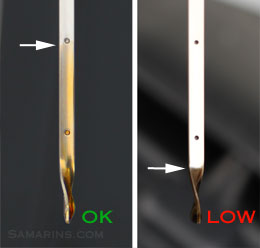It's really not that difficult to keep your car in good shape. Here are the basics:
- Read your car owner's manual, it has all the information on car maintenance as well as safety precautions.
- Keep all the fluids (e.g. engine oil, transmission fluid, coolant, etc.) clean and topped up.
- Follow your maintenance schedule, there is a number of things that need to be regularly serviced or replaced at certain intervals (e.g. brakes, air filter, timing belt, spark plugs, etc.)
- Check tire pressure regularly.
- Change you windshield wipers if they don't clean properly.
- Wash and wax your vehicle once in a while to keep the car finish shiny and protected from corrosion.
- Deal with any problems as soon as they arise, before they become more serious and require expensive repairs.
- Use only original parts.
- At least once a year have your car check out in a garage.
 The engine air filter keeps the air entering the engine
clean, but over time the filter gets dirty and restricts the air flow.
The engine air filter is usually recommended to be replaced every
12,000-15,000 miles or 20,000-24,000 km. Typically the air filter gets
checked when you bring your car for an oil change. If you want to check
it or replaced yourself, on most cars and trucks it's a fairly easy
task. Your owner's manual has the directions. If you find that the air
filter is dirty, replaced it; it's not a very expensive part. It's best
to use an original air filter that you can buy at your local dealership
parts department; usually it costs around $20. When you are
installing the air filter, make sure it's installed correctly; again,
check your owner's manual. If the filter is not installed properly,
unfiltered air entering the engine could damage the airflow sensor and
increase engine wear.
The engine air filter keeps the air entering the engine
clean, but over time the filter gets dirty and restricts the air flow.
The engine air filter is usually recommended to be replaced every
12,000-15,000 miles or 20,000-24,000 km. Typically the air filter gets
checked when you bring your car for an oil change. If you want to check
it or replaced yourself, on most cars and trucks it's a fairly easy
task. Your owner's manual has the directions. If you find that the air
filter is dirty, replaced it; it's not a very expensive part. It's best
to use an original air filter that you can buy at your local dealership
parts department; usually it costs around $20. When you are
installing the air filter, make sure it's installed correctly; again,
check your owner's manual. If the filter is not installed properly,
unfiltered air entering the engine could damage the airflow sensor and
increase engine wear.
- Read your car owner's manual, it has all the information on car maintenance as well as safety precautions.
- Keep all the fluids (e.g. engine oil, transmission fluid, coolant, etc.) clean and topped up.
- Follow your maintenance schedule, there is a number of things that need to be regularly serviced or replaced at certain intervals (e.g. brakes, air filter, timing belt, spark plugs, etc.)
- Check tire pressure regularly.
- Change you windshield wipers if they don't clean properly.
- Wash and wax your vehicle once in a while to keep the car finish shiny and protected from corrosion.
- Deal with any problems as soon as they arise, before they become more serious and require expensive repairs.
- Use only original parts.
- At least once a year have your car check out in a garage.
Checking the engine oil
Check engine oil regularly, especially if you notice that the oil level drops between the oil changes. Engine oil cools down and lubricates the engine. Driving with very low oil level can cause engine problems. Park your vehicle on a level ground. Set the parking
brake. Make sure the transmission is in "Park." Stop the engine. Wait
for a minute or two to let engine oil drain into the oil pan. Pull the
engine oil
dipstick. If you don't know where is it located, check
your owner's manual, usually it has a bright handle saying "Engine Oil".
Park your vehicle on a level ground. Set the parking
brake. Make sure the transmission is in "Park." Stop the engine. Wait
for a minute or two to let engine oil drain into the oil pan. Pull the
engine oil
dipstick. If you don't know where is it located, check
your owner's manual, usually it has a bright handle saying "Engine Oil". |
 Wipe the dipstick off. Insert it back fully. Pull it out again and check the oil level.
Wipe the dipstick off. Insert it back fully. Pull it out again and check the oil level. |
 The oil level should be between the "Low" and "Full" marks. In this photo the level is OK and oil looks clean.
The oil level should be between the "Low" and "Full" marks. In this photo the level is OK and oil looks clean. |
 Check
the oil condition: If it's way too black, as in the left
photo, it's definitely time to change it. If it's brown, but still
clean and transparent, as in the right photo, it's OK.
If oil looks clean, but the level is low, you can just
top it up.
Check
the oil condition: If it's way too black, as in the left
photo, it's definitely time to change it. If it's brown, but still
clean and transparent, as in the right photo, it's OK.
If oil looks clean, but the level is low, you can just
top it up. |
 In this car, the oil level is below the "Low" mark. Driving with low oil level like this can damage your engine.
In this car, the oil level is below the "Low" mark. Driving with low oil level like this can damage your engine. |
 To top up engine oil use a recommended type of oil; for
example, if your owner's manual or the oil filler cap indicates SAE
5W-20, use SAE 5W-20 oil. If your engine needs synthetic oil, use only
synthetic oil. You can find the recommended oil type for your car in
your owner's manual.
To top up engine oil use a recommended type of oil; for
example, if your owner's manual or the oil filler cap indicates SAE
5W-20, use SAE 5W-20 oil. If your engine needs synthetic oil, use only
synthetic oil. You can find the recommended oil type for your car in
your owner's manual. |
 How to top up engine oil:
How to top up engine oil: Add a small amount of oil into the oil filler neck. Wait for a couple of minutes to let oil to flow into the oil pan. Check the oil level again with the dipstick. If it's still low, add some more. But don't overfill it. Don't forget to install the dipstick back and close the oil filler cap when you are done. |
Engine coolant (antifreeze)
 Visually check the engine coolant level in the overflow
tank. Your owner's manual has the directions. The level should be
between "Low" and "Full" marks. (Don't
open the radiator cap or the pressurized overflow tank cap when the
engine is hot! The cooling system is under pressure when hot!) If
the coolant level is low, you can top it up using recommended type of
coolant mixed with water. Again, your owner's manual has the proper way
to do it.
Visually check the engine coolant level in the overflow
tank. Your owner's manual has the directions. The level should be
between "Low" and "Full" marks. (Don't
open the radiator cap or the pressurized overflow tank cap when the
engine is hot! The cooling system is under pressure when hot!) If
the coolant level is low, you can top it up using recommended type of
coolant mixed with water. Again, your owner's manual has the proper way
to do it. |
 Add coolant only when the engine is cool.
Use only recommended engine coolant. Sometimes engine
coolant is sold already premixed with water and sometimes you will have
to mix it. Check you owner's manual or read the directions on the
coolant bottle. Carefully add the coolant into the overflow tank to
make it between "LOW" and "FULL" marks.
Add coolant only when the engine is cool.
Use only recommended engine coolant. Sometimes engine
coolant is sold already premixed with water and sometimes you will have
to mix it. Check you owner's manual or read the directions on the
coolant bottle. Carefully add the coolant into the overflow tank to
make it between "LOW" and "FULL" marks. |
 If the coolant level drops within a short time after
topping up, there may be a leak. Have the coolant system checked - lack
of coolant may cause the engine to overheat which may result in serious
damage.
If the coolant level drops within a short time after
topping up, there may be a leak. Have the coolant system checked - lack
of coolant may cause the engine to overheat which may result in serious
damage. |
Engine air filter
 The engine air filter keeps the air entering the engine
clean, but over time the filter gets dirty and restricts the air flow.
The engine air filter is usually recommended to be replaced every
12,000-15,000 miles or 20,000-24,000 km. Typically the air filter gets
checked when you bring your car for an oil change. If you want to check
it or replaced yourself, on most cars and trucks it's a fairly easy
task. Your owner's manual has the directions. If you find that the air
filter is dirty, replaced it; it's not a very expensive part. It's best
to use an original air filter that you can buy at your local dealership
parts department; usually it costs around $20. When you are
installing the air filter, make sure it's installed correctly; again,
check your owner's manual. If the filter is not installed properly,
unfiltered air entering the engine could damage the airflow sensor and
increase engine wear.
The engine air filter keeps the air entering the engine
clean, but over time the filter gets dirty and restricts the air flow.
The engine air filter is usually recommended to be replaced every
12,000-15,000 miles or 20,000-24,000 km. Typically the air filter gets
checked when you bring your car for an oil change. If you want to check
it or replaced yourself, on most cars and trucks it's a fairly easy
task. Your owner's manual has the directions. If you find that the air
filter is dirty, replaced it; it's not a very expensive part. It's best
to use an original air filter that you can buy at your local dealership
parts department; usually it costs around $20. When you are
installing the air filter, make sure it's installed correctly; again,
check your owner's manual. If the filter is not installed properly,
unfiltered air entering the engine could damage the airflow sensor and
increase engine wear.
No comments:
Post a Comment